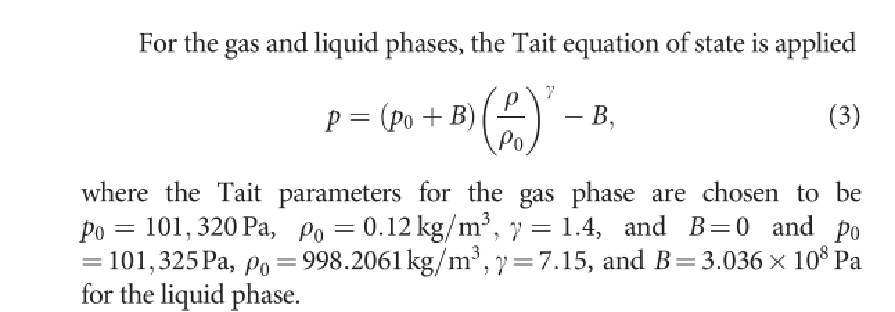TAGGED: #fluent-#cfd-#ansys, #multiphase_models, 2021-r1, udf
-
-
December 22, 2024 at 1:22 pm
ntwy88
SubscriberI am using VOF to calculate two-phase flow and I need to simulate a situation where there is negative pressure in compressible liquid liquid water. After I use udf to change the equation of state of air to Tait's equation, and derive the sound velocity equation according to Tait's equation, both imported as compiled udf, I can't calculate the velocity of compressible liquid liquid water over 20m/s, where is the error that needs to be modified?
Thank you.
-
December 23, 2024 at 10:16 am
Rob
Forum ModeratorIf you're changing density with pressure you can only use ideal gas, real gas or compressible liquid.
What happens at 20m/s?
-
December 23, 2024 at 12:47 pm
ntwy88
SubscriberThank you for your response. One question here is that the equation of state for compressible liquids in fluent is Tait's equation, may I ask if you mean not to write it as udf? I want to model a situation where negative pressure occurs in liquid water, and the air equation of state can't have negative pressure using an ideal gas. After I modified the equation of state for air using udf according to Tait's equation, it shows floating point overflow non-convergence when compressible liquid water droplet velocity exceeds 20m/s hitting the wall in still air.
-
-
December 23, 2024 at 1:21 pm
Rob
Forum ModeratorFluent has some internal logic for density that means you can't code up pressure dependent density unless it's real gas: you use the built in models otherwise. Not sure how you'd have "negative pressure" as we usually solve against gauge.
-
December 23, 2024 at 1:34 pm
ntwy88
SubscriberThank you for your response. The impact of a high-speed droplet on a solid surface produces a transient region of high pressure at the point of impact, with subsequent propagation of shock waves. These shock waves propagate inside the droplet and are reflected at the distal end of the droplet, forming a series of sparse waves. The reflected sparse waves are focused inside the droplet, thus creating a localized negative pressure at the distal end of the droplet. This negative pressure is due to the fact that the liquid is stretched by the reflected waves, resulting in a region of negative pressure where the tension in the liquid exceeds its intrinsic pressure. The negative pressure here is the absolute pressure. Should I use a the VOF model in fluent and set both air and liquid water as compressible liquids and then calculate?
-
-
December 23, 2024 at 1:46 pm
Rob
Forum ModeratorVOF should be fine, with air as ideal gas and water as a compressible liquid. Your problem is then going to be resolving the droplets sufficiently and then time scales to resolve the shocks. Not an easy model to run.
-
December 23, 2024 at 1:52 pm
ntwy88
SubscriberThank you for your response. Another question is that my calculations considering air as an ideal gas and water as a compressible liquid water do not capture the creation of negative pressure, is this because the ideal gas does not accept the presence of negative pressure, resulting in the inability of negative pressure to occur inside the droplet? Or is there any other reason?
-
-
December 23, 2024 at 2:10 pm
Rob
Forum ModeratorWater as a liquid will compress/expand as per the model. Beyond that you'll get cavitation, which is another set of models.
-
December 23, 2024 at 2:25 pm
ntwy88
SubscriberThank you for your response. You are right, but I don't consider cavitation in my simulations. I have found in the verified literature that they consider it is not necessary to take into account the thermal effects, although OPENFOAM is used in the literature.
-
-
December 23, 2024 at 2:33 pm
Rob
Forum ModeratorCavitation isn't just a thermal effect: it's a cold flow phenomena too.
-
December 23, 2024 at 2:59 pm
ntwy88
SubscriberThank you for your reply. So, may I ask if you mean to add a cavitation model?
-
-
December 23, 2024 at 3:10 pm
Rob
Forum ModeratorYou may need to. However as I don't know what you're after it's difficult to say, and I'm a little limited into how much advice I can offer. Talk it through with your project supervisor.
-
December 24, 2024 at 2:21 am
ntwy88
SubscriberThank you very much for your reply.
-
-
- You must be logged in to reply to this topic.


- air flow in and out of computer case
- Varying Bond model parameters to mimic soil particle cohesion/stiction
- Eroded Mass due to Erosion of Soil Particles by Fluids
- I am doing a corona simulation. But particles are not spreading.
- Issue to compile a UDF in ANSYS Fluent
- Guidance needed for Conjugate Heat Transfer Analysis for a 3s3p Li-ion Battery
- JACOBI Convergence Issue in ANSYS AQWA
- affinity not set
- Resuming SAG Mill Simulation with New Particle Batch in Rocky
- Continuing SAG Mill Simulation with New Particle Batch in Rocky

-
4492
-
1494
-
1376
-
1209
-
1021

© 2025 Copyright ANSYS, Inc. All rights reserved.








